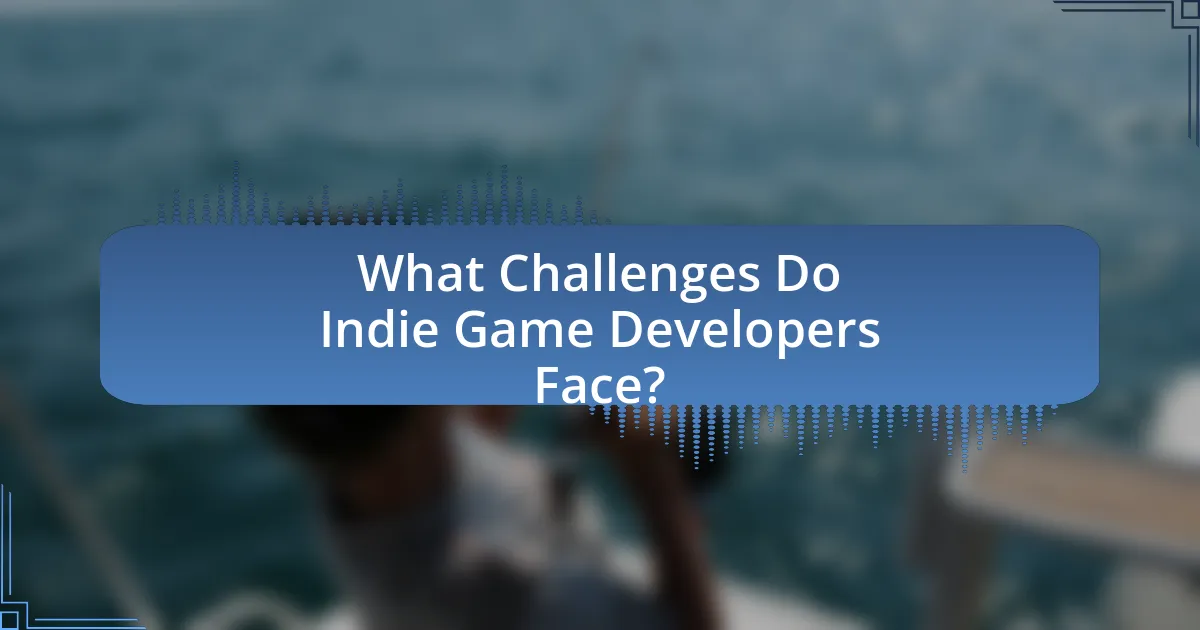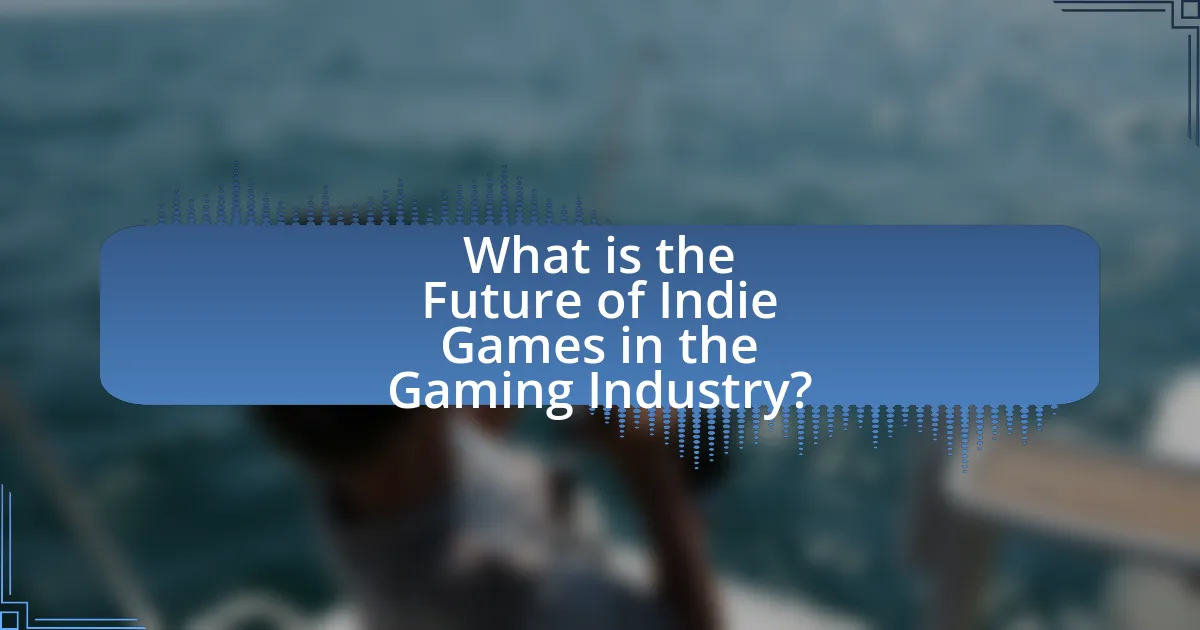The article focuses on the rise of indie games, which are developed by individuals or small teams without major publisher support, highlighting their significance in fostering innovation and creativity within the gaming industry. It contrasts indie games with AAA titles, emphasizing their unique gameplay, storytelling, and artistic expression. The piece discusses the factors contributing to the surge in indie game popularity, including technological advancements and community engagement, while also addressing the challenges faced by indie developers, such as funding and marketing difficulties. Key characteristics of successful indie games, common themes explored, and the evolving perception of indie games within the gaming community are also examined, alongside future trends and practical tips for aspiring developers.

What are Indie Games and Why are They Significant?
Indie games are video games developed by individuals or small teams without the financial support of a large game publisher. They are significant because they foster innovation and creativity in the gaming industry, often resulting in unique gameplay experiences and storytelling that differ from mainstream titles. The rise of platforms like Steam and itch.io has enabled indie developers to reach wider audiences, leading to successful titles such as “Undertale” and “Hollow Knight,” which have garnered critical acclaim and commercial success. This shift has democratized game development, allowing diverse voices and ideas to emerge, thus enriching the gaming landscape.
How do Indie Games differ from AAA Games?
Indie games differ from AAA games primarily in their development scale and funding sources. Indie games are typically created by small teams or individual developers with limited budgets, allowing for more creative freedom and innovation, while AAA games are produced by large studios with significant financial backing, resulting in high production values and extensive marketing campaigns. For example, the indie game “Celeste,” developed by a small team, received critical acclaim for its unique gameplay and storytelling, whereas “Call of Duty,” a AAA title, is known for its high-budget graphics and extensive multiplayer features. This distinction highlights how indie games often prioritize artistic expression and niche audiences, while AAA games focus on mass appeal and technical advancements.
What defines an Indie Game in terms of development and funding?
An Indie Game is defined by its independent development and funding, typically created by small teams or individuals without the backing of major publishers. These games often prioritize creative freedom and innovation over commercial viability, allowing developers to explore unique concepts and artistic visions. For instance, titles like “Celeste” and “Hollow Knight” exemplify how indie games can achieve critical acclaim and commercial success despite limited budgets, often funded through personal savings, crowdfunding platforms like Kickstarter, or small-scale investments. This model contrasts with mainstream games, which usually involve large teams and significant financial resources from established publishers.
How does the creative freedom in Indie Games impact gameplay and storytelling?
Creative freedom in indie games significantly enhances gameplay and storytelling by allowing developers to explore unique concepts and narratives without the constraints typically imposed by larger studios. This autonomy enables the creation of innovative mechanics and diverse storytelling techniques, often resulting in experiences that challenge conventional gaming norms. For instance, games like “Undertale” and “Celeste” showcase how indie developers can craft emotionally resonant stories and gameplay that prioritize player choice and personal connection, leading to a more immersive experience. The success of these titles illustrates that the lack of corporate oversight can foster originality, making indie games a vital part of the evolving gaming landscape.
Why has the popularity of Indie Games surged in recent years?
The popularity of Indie Games has surged in recent years due to increased accessibility for developers and a growing audience seeking unique gaming experiences. Advances in technology, such as affordable game development tools and platforms like Steam and itch.io, have enabled independent developers to create and distribute their games without the need for large publishers. Additionally, the rise of social media and streaming platforms has allowed Indie Games to gain visibility and build communities around them, leading to increased player engagement. According to a report by the Entertainment Software Association, the number of Indie Games released has more than doubled from 2015 to 2020, reflecting this growing trend.
What technological advancements have facilitated the rise of Indie Games?
Technological advancements such as accessible game development tools, digital distribution platforms, and powerful hardware have facilitated the rise of Indie Games. Game engines like Unity and Unreal Engine provide user-friendly interfaces and extensive resources, allowing developers to create high-quality games with minimal investment. Digital distribution platforms like Steam and itch.io enable Indie developers to reach global audiences without the need for traditional publishing, significantly lowering barriers to entry. Additionally, advancements in hardware, including affordable PCs and consoles, have made it easier for Indie developers to produce and distribute their games, contributing to a diverse gaming landscape.
How has the gaming community’s perception of Indie Games evolved?
The gaming community’s perception of Indie Games has evolved from viewing them as niche, low-budget alternatives to mainstream titles, to recognizing them as innovative and valuable contributors to the gaming landscape. Initially, Indie Games were often associated with limited production quality and smaller audiences; however, successful titles like “Braid” and “Super Meat Boy” demonstrated that Indie Games could offer unique gameplay experiences and compelling narratives. This shift is further evidenced by the increasing presence of Indie Games at major gaming events, such as the Independent Games Festival, which showcases their artistic and creative potential. Additionally, platforms like Steam and itch.io have facilitated greater visibility and accessibility for Indie developers, leading to a broader acceptance and appreciation within the gaming community.

What are the Key Characteristics of Successful Indie Games?
Successful indie games typically exhibit creativity, unique gameplay mechanics, and strong narrative elements. Creativity allows indie developers to explore unconventional ideas and art styles, setting their games apart from mainstream titles. Unique gameplay mechanics often provide fresh experiences that engage players in innovative ways, while strong narratives can create emotional connections, enhancing player investment. For instance, games like “Celeste” and “Hollow Knight” have gained acclaim for their distinctive art and storytelling, contributing to their commercial success. These characteristics are essential in a competitive market where originality and player engagement are crucial for standing out.
What themes and genres are commonly explored in Indie Games?
Indie games commonly explore themes such as identity, mental health, and social issues, alongside genres like platformers, puzzle games, and narrative-driven experiences. These themes resonate with players due to their personal and relatable nature, often reflecting real-world challenges and emotions. For instance, games like “Celeste” tackle mental health through gameplay mechanics and storytelling, while titles like “Undertale” address themes of morality and choice. The diversity in genres allows indie developers to experiment with innovative gameplay and storytelling techniques, contributing to the unique identity of the indie game scene.
How do narrative and art style contribute to the success of Indie Games?
Narrative and art style significantly contribute to the success of indie games by creating unique experiences that resonate with players. A compelling narrative engages players emotionally, often leading to deeper connections with the game, as seen in titles like “Celeste,” which explores themes of mental health and personal growth. Additionally, distinctive art styles, such as the pixel art in “Stardew Valley” or the hand-drawn visuals in “Hollow Knight,” set indie games apart from mainstream titles, attracting players who appreciate creativity and innovation. This combination of engaging storytelling and unique visual presentation not only enhances player immersion but also fosters community discussions and word-of-mouth promotion, which are crucial for the success of indie games.
What role does innovation play in the development of Indie Games?
Innovation is crucial in the development of indie games as it allows developers to create unique gameplay experiences that differentiate their products in a crowded market. Indie developers often lack the resources of larger studios, so they leverage innovative ideas, mechanics, and storytelling techniques to attract players. For instance, games like “Celeste” and “Hollow Knight” introduced novel gameplay elements and emotional narratives, which contributed to their critical and commercial success. This emphasis on innovation not only fosters creativity but also encourages experimentation, leading to diverse gaming experiences that challenge traditional industry norms.
How do Indie Games engage with their audience?
Indie games engage with their audience through community interaction, unique storytelling, and innovative gameplay mechanics. Developers often utilize social media platforms, forums, and live streams to communicate directly with players, fostering a sense of community and feedback. For instance, games like “Hollow Knight” and “Celeste” have built strong communities by actively involving players in discussions about game updates and features. Additionally, indie games frequently explore niche themes and personal narratives, which resonate deeply with players, enhancing emotional investment. This engagement strategy is supported by statistics showing that 70% of indie game players feel a stronger connection to games that involve community feedback during development.
What marketing strategies are effective for Indie Game developers?
Effective marketing strategies for Indie Game developers include leveraging social media platforms, engaging with gaming communities, and utilizing crowdfunding campaigns. Social media platforms like Twitter, Instagram, and TikTok allow developers to showcase their games, share development updates, and connect with potential players, which is crucial given that 72% of gamers discover new games through social media. Engaging with gaming communities on platforms such as Discord and Reddit fosters a loyal fanbase and provides direct feedback, enhancing game development and marketing efforts. Additionally, crowdfunding campaigns on sites like Kickstarter not only raise funds but also create a community of early supporters, with successful campaigns often exceeding their funding goals by significant margins, demonstrating the effectiveness of this strategy.
How do community feedback and player involvement shape Indie Games?
Community feedback and player involvement significantly shape Indie Games by directly influencing game design, development priorities, and overall player experience. Indie developers often rely on platforms like Steam and social media to gather player opinions, which can lead to iterative changes based on user suggestions. For instance, a survey by the International Game Developers Association found that 70% of indie developers actively seek player feedback during the development process, demonstrating its importance. This engagement not only helps refine gameplay mechanics but also fosters a sense of community ownership, making players feel invested in the game’s success.

What Challenges Do Indie Game Developers Face?
Indie game developers face significant challenges, including limited funding, marketing difficulties, and resource constraints. Limited funding restricts their ability to hire skilled personnel or invest in high-quality assets, which can hinder game development and polish. Marketing difficulties arise from the saturated market, making it hard for indie games to gain visibility among consumers; for instance, over 10,000 games were released on Steam in 2020 alone, highlighting the competition. Resource constraints, such as small teams and lack of access to advanced technology, further complicate the development process, often leading to burnout and project delays. These challenges collectively impact the success and sustainability of indie game studios.
How do funding and financial constraints impact Indie Game development?
Funding and financial constraints significantly impact indie game development by limiting resources for production, marketing, and distribution. Indie developers often operate with smaller budgets compared to larger studios, which restricts their ability to hire skilled personnel, invest in advanced technology, and allocate funds for extensive marketing campaigns. For instance, a 2020 report by the International Game Developers Association indicated that 70% of indie developers cited funding as a major challenge, affecting their project timelines and overall game quality. Consequently, financial limitations can lead to compromises in game design, reduced scope, and ultimately, a lower chance of commercial success.
What are common pitfalls in the Indie Game development process?
Common pitfalls in the Indie Game development process include scope creep, inadequate planning, and lack of marketing strategy. Scope creep occurs when developers continuously add features beyond the original plan, leading to project delays and budget overruns. Inadequate planning often results in missed deadlines and unfulfilled project goals, as many indie developers underestimate the time and resources required. Additionally, a lack of marketing strategy can lead to poor visibility and sales, as many indie games fail to reach their target audience without effective promotion. These pitfalls are frequently cited in industry reports, such as the Game Developer’s Conference, which highlights that 70% of indie developers struggle with project management and marketing challenges.
How can Indie developers overcome marketing challenges?
Indie developers can overcome marketing challenges by leveraging social media platforms and engaging directly with their target audience. Utilizing platforms like Twitter, Instagram, and TikTok allows developers to showcase their games, share development updates, and build a community around their projects. According to a study by the International Game Developers Association, 70% of indie developers reported that social media was their most effective marketing tool. Additionally, participating in game festivals and online events can increase visibility and attract potential players, as these events often provide opportunities for networking and feedback.
What support systems exist for Indie Game developers?
Support systems for Indie Game developers include funding platforms, community networks, and development tools. Funding platforms like Kickstarter and Indiegogo allow developers to raise capital directly from potential players, with Kickstarter reporting over $1 billion pledged to game projects since its inception. Community networks such as IndieDB and TIGSource provide forums for collaboration, feedback, and promotion, fostering a sense of belonging among developers. Additionally, development tools like Unity and Unreal Engine offer accessible resources for game creation, with Unity boasting over 1.5 million monthly active users, enabling developers to create high-quality games without extensive financial investment. These systems collectively enhance the viability and success of Indie Game developers in a competitive market.
How do game festivals and competitions benefit Indie developers?
Game festivals and competitions benefit Indie developers by providing exposure, networking opportunities, and potential funding. These events allow Indie developers to showcase their games to a wider audience, including industry professionals and potential players, which can lead to increased visibility and sales. For instance, events like the Independent Games Festival have historically helped launch successful titles, with winners often receiving significant media attention and distribution deals. Additionally, networking at these festivals can connect developers with publishers, investors, and collaborators, facilitating partnerships that can enhance their projects. Furthermore, competitions often offer cash prizes or grants, which can provide crucial financial support for Indie developers to continue their work.
What role do online platforms play in promoting Indie Games?
Online platforms play a crucial role in promoting Indie Games by providing accessible distribution channels and marketing opportunities. These platforms, such as Steam, itch.io, and the Epic Games Store, allow independent developers to reach a global audience without the need for traditional publishing deals. For instance, Steam reported that over 30% of its revenue comes from Indie titles, highlighting the significant market presence these games can achieve through online distribution. Additionally, social media and streaming services like Twitch and YouTube enable developers to engage directly with potential players, fostering community support and increasing visibility. This direct interaction can lead to higher sales and a dedicated fan base, demonstrating the effectiveness of online platforms in elevating Indie Games in the competitive gaming market.

What is the Future of Indie Games in the Gaming Industry?
The future of indie games in the gaming industry is promising, characterized by increased accessibility, innovation, and community support. As technology advances, indie developers can leverage tools like Unity and Unreal Engine, which lower development costs and enhance creativity. The success of titles such as “Hollow Knight” and “Celeste” demonstrates that indie games can achieve commercial viability and critical acclaim, encouraging more developers to enter the market. Additionally, platforms like Steam and itch.io provide indie developers with direct access to consumers, facilitating a more diverse gaming landscape. According to a report by the International Game Developers Association, 70% of developers identify as indie, indicating a significant and growing segment within the industry.
How might emerging technologies influence Indie Game development?
Emerging technologies significantly influence Indie Game development by providing accessible tools and platforms that lower barriers to entry. For instance, advancements in game engines like Unity and Unreal Engine enable indie developers to create high-quality graphics and complex gameplay without extensive resources. Additionally, the rise of cloud gaming and distribution platforms such as Steam and itch.io allows indie games to reach global audiences more easily, facilitating wider exposure and sales. Furthermore, technologies like virtual reality (VR) and augmented reality (AR) offer innovative gameplay experiences that can differentiate indie titles in a crowded market. These factors collectively empower indie developers to innovate and compete effectively in the gaming industry.
What trends are shaping the future landscape of Indie Games?
The future landscape of Indie Games is being shaped by several key trends, including increased accessibility to development tools, the rise of digital distribution platforms, and a growing emphasis on narrative-driven experiences. Accessibility to development tools, such as Unity and Unreal Engine, allows more creators to enter the market, leading to a diverse range of game styles and innovations. Digital distribution platforms like Steam and itch.io provide indie developers with direct access to global audiences, significantly reducing the barriers to entry. Additionally, the focus on narrative-driven experiences caters to players seeking deeper emotional connections, as evidenced by successful titles like “Celeste” and “Hades,” which have garnered critical acclaim and commercial success. These trends collectively indicate a vibrant and evolving future for indie games.
How can Indie Games continue to innovate and capture player interest?
Indie games can continue to innovate and capture player interest by leveraging unique storytelling, experimental gameplay mechanics, and community engagement. Unique storytelling allows indie developers to explore diverse narratives that mainstream games often overlook, creating emotional connections with players. Experimental gameplay mechanics, such as unconventional controls or innovative level design, can provide fresh experiences that differentiate indie titles from larger productions. Community engagement, through platforms like Discord or social media, fosters a loyal player base and encourages feedback, which can guide future updates and expansions. For instance, games like “Hollow Knight” and “Celeste” have successfully utilized these strategies, resulting in critical acclaim and strong sales, demonstrating that innovation and player interest can be effectively maintained in the indie game sector.
What practical tips can aspiring Indie Game developers follow?
Aspiring indie game developers should focus on creating a prototype to test their game ideas quickly. Prototyping allows developers to validate concepts, gather feedback, and iterate on gameplay mechanics without investing excessive time or resources. According to a study by the International Game Developers Association, 70% of successful indie games started with a prototype that was refined based on player feedback. Additionally, developers should engage with online communities for support and resources, as collaboration and networking can lead to valuable insights and opportunities.
How can developers effectively manage their resources and time?
Developers can effectively manage their resources and time by implementing agile methodologies, which promote iterative development and regular reassessment of project goals. Agile practices, such as Scrum or Kanban, allow developers to prioritize tasks, allocate resources efficiently, and adapt to changes quickly. Research indicates that teams using agile methodologies can improve productivity by up to 25% compared to traditional project management approaches. Additionally, utilizing project management tools like Trello or Asana helps in tracking progress and deadlines, ensuring that resources are utilized optimally.
What best practices should be considered when launching an Indie Game?
When launching an Indie Game, developers should prioritize effective marketing strategies, community engagement, and thorough testing. Effective marketing strategies include building a strong online presence through social media, creating a compelling website, and utilizing platforms like Steam and itch.io for visibility. Community engagement is crucial; developers should interact with potential players through forums, Discord, and social media to build a loyal fanbase. Thorough testing ensures a polished product, reducing bugs and enhancing user experience, which is vital for positive reviews and word-of-mouth promotion. According to a 2021 report by the International Game Developers Association, 70% of successful Indie Games attributed their success to strong community engagement and marketing efforts.

